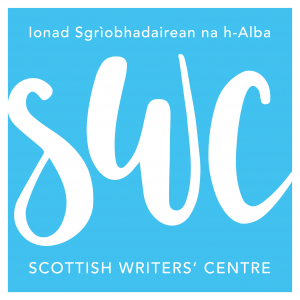The Scottish Writers’ Centre burned our first solstice ‘Bonfire for the Writers’ with Ian Stephen on Tuesday night. Thank you to everyone who joined us. Stephen, a ‘Lewis man’ who served fifteen years working for the Coastguard rolled in from the sea to his ‘In Process’ Masterclass and told us that he launched his first piece of writing here:
“In this very building, at the Third Eye Centre before it was the CCA : Centre for Contemporary Arts.”’
Stephen is a writer, poet, artist, storyteller and a sailor. Born in Stornoway he’s still living on the Isle of Lewis in the Outer Hebrides where his novel, A Book of Death and Fish (2014) is set. Stephen began his journey by boat from Rathkin Island to Oban travelling by land to Glasgow.
He brought along a sample of publications and a copy of his titanic novel, A Book of Death and Fish (2014), telling us he will concentrate on this book to discuss his writing process, but would also make use of his other publications, he points to the table, and begins reading. We sit listening to a soothing island brogue touched by the waves he grew up surrounded by. Stephen is reading us the story of another island man, Peter MacAuley. He recommends:
“Reading your work out loud, it helps set the tone of the book and helps you understand what works and what doesn’t.”
In fact, he did the same with his manuscript. He read it aloud to his wife, who at the time had a broken ankle and enjoys being read to. He reads to her, to get the tone:
“It helped me with the redrafting and the editing process.”
It didn’t quite work though, or rather, in his case it did because he had agreed with his publisher to take an 80,000 word book down to 75,000 and by the time he’d finished the rewrites, A Book of Death and Fish (2014) had risen to 90,000 words.
Stephen reveals that this book was written over fifteen years and consisted of a mix of maps, routes, navigational notes, stories, thoughts, reflections, weather forecasts, and everything else a sailor collects on a journey through the every day.
He chews over reading and chats about his first job that he thought was going to be working in the fishing industry but ended up at the Forestry Commission. This allowed him the time to indulge his reading habit.
During those early years Stephen took up a Teaching Degree in English and comments:
“I was training to be an English teacher but decided not to go into teaching. I admire people who can teach and still write. Teaching takes so much out of you.”
While studying, Stephen attended a Seminar on Thomas Crawford who wrote about Burns and Scott and neither of whom, at that time, Stephen had read. When he did read Scott after some scolding encouragement from his mother, Stephen first read, The Heart of Midlothian (1818) and was pleasantly surprised and amazed.
He has noted since, how Scott has inspired many writers and citied James Robertson’s, And the Land Lay Still (2010). Stephen switches gears:
“My main interest was in poetry. I joined a writing group to make something. There are two types of writing. You have a product, an idea, an audience. Or, my type of writing, you haven’t got a clue what form it’s going to take.”
He talks about his work as an artist and the Scot’s word Makar, a ‘maker of things, a poet’ and shares his thoughts on poetry and writing outside yourself.
At that time, he was passionate about his book. He wanted it to be a serious of short stories. That was the form that he thought his writing would take and that is what he was interested in.
Inspired by another Seminar, Stephen was introduced to American short story writer, Sherwood Anderson. He referenced Anderson’s, Hands:
“I noticed there was this thing going on where in his short stories things didn’t join up, but it all added up to something. His stories were held together with motifs rather than narrative. I liked how things hung together. It gives creation to writing from another edge. I’m not linear, the national standards don’t come naturally to a Lewis man. ”
He laughs, a jolly chuckle as he shares with us his notes, note pads and the example he brings of his first reading of the book for re-drafting. It has a zillion yellow sticky notes attached. Stories, poetry, travel times, and even original island recipes, as one member noted, are all part of the book. An entry into a Log Book could be the inspiration and starting point for writing. A multidisciplinary writer, Stephen experiments with art and artists and considered his series of notebooks very much like a drawing. He knew he was trying to get at something, there was a story holding all of this together, he just didn’t know where it was going.
Twenty five years later, Stephen phoned Dr. Gavin Wallace of Creative Scotland and told him he needed support, for two years, to work on his manuscript. When Wallace asked him what his idea was, Stephen responded, “ I can’t really tell you until I get that time to focus on my notes.” Wallace informed him there was serious competition for funds. Despite the competition, Stephen eventually got the support and was granted the bursary. He advocates the importance of bursaries and how we’re fortunate that they are available:
“This gave me two years of absolute focus that gave shape to the story. For me it was only the beginning. Things began to take shape and main characters began to come forward. Through this process I was able to realise who the central character was. I got a sustained run at it. I was hungry for it. I wanted that sustained time for a long time. I made really good use of that time. There was a lot of writing. ”
After many years going through his stacks of notebooks, Stephen knew he had something but the mechanics of putting it together was still puzzling him. He was interested in his character, Peter MacAuley whose father, a weaver suddenly dies. His interest is in the appeal of stories through the hidden parts of them was garnering. The parts left untold, reading between the lines, and what isn’t said were the things that interested him about people and their stories. Stephen was experimenting, finding his way.
Stephen’s background working in several art forms led to him living from project to project while concentrating on shaping his work. He talks about using real characters in real towns and how his story is based on those who live in his town and how he addressed that:
“People don’t like it. George McKay Brown considered it part of being a writer. It really is easier to write about what you know. Writing for theatre taught me a lot about building characters. I try to liven things up by taking real characters and borrowing elements from other characters or changing physical characteristics. Some of it is made up. I mix and match, do anything I want, but try to write about what actually happened. I’m not sure what I would have done if anyone had said I’m not happy about that. Yet there are biographical elements to everyone I know in and out of the book”
He discusses consistency and how important being consistent with an aging narrator can correspond with a shift in the story. How intuitively some of his stories link up and, how afterwards, he realises he was unconscious of it. There were issues to deal with during the redrafting. Bringing out similar elements and, melding together characters that were too alike were examples Stephen gave.
There were other factors and people involved in the journey of this masterpiece. Stephen sourced and sought advice from writers and publishers to read his manuscript to find out its worth. He asked an editor working for a publisher, an American friend, someone living outside of Scotland, and a woman, to get different viewpoints and perspectives. The feedback was positive and he was advised to ‘stick with it.’ He leaves us with this advice:
“While it’s not easy, find a publisher whose writing you believe in and they believe in you. And, not all publishers may be open to suggestions. With a book not written for a specific market and that doesn’t have a traditional shape or content, a good relationship with a publisher is important. Saraband asked me, is this the book you want? And, I said, yes it is.”
He smiles at us and begins an engaging questioning and answering session. Some of us follow Ian down to the bar to enjoy a drink, and more conversation in his company.
To learn more about Ian Stephen:
The Guardian Review: A Book of Death and Fish(2014) by Ian Stephen:
http://bookshop.theguardian.com/book-of-death-and-fish.html
June 2015: Paperback version released: A Book of Death and Fish by Ian Stephen paperback version released:




